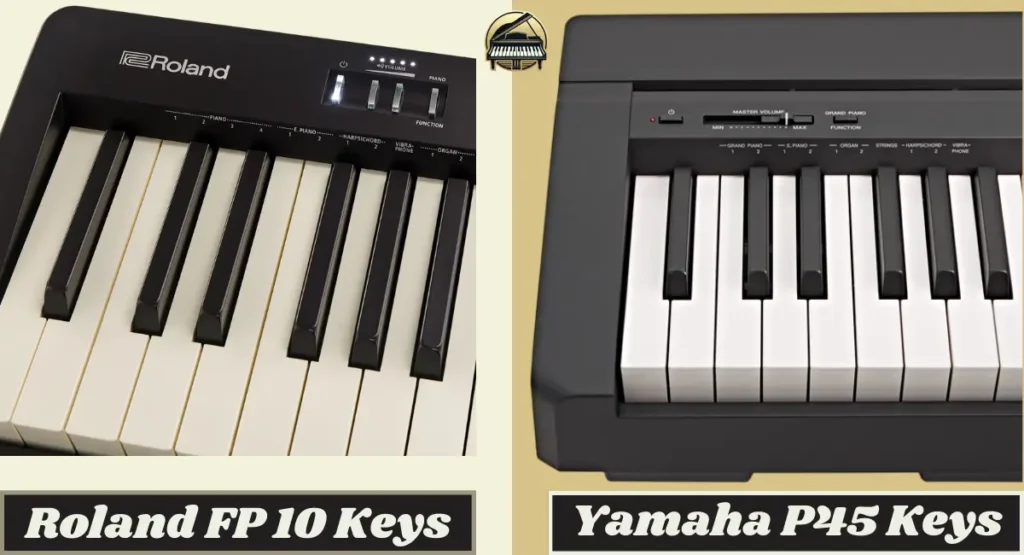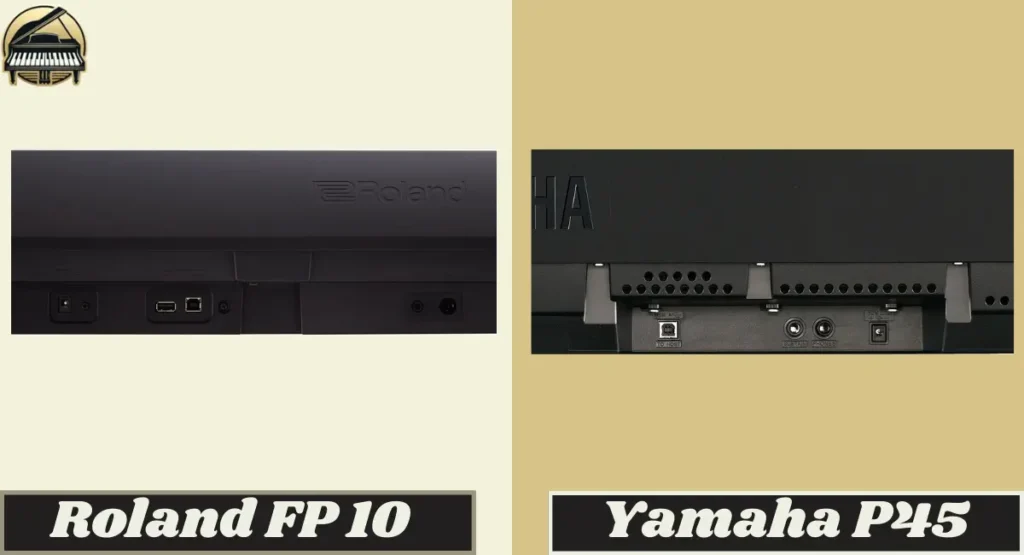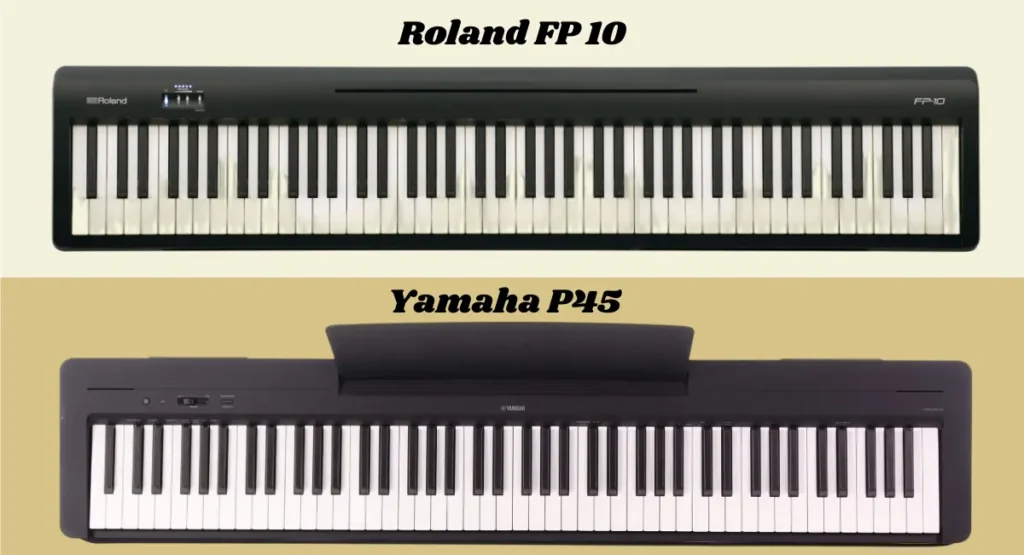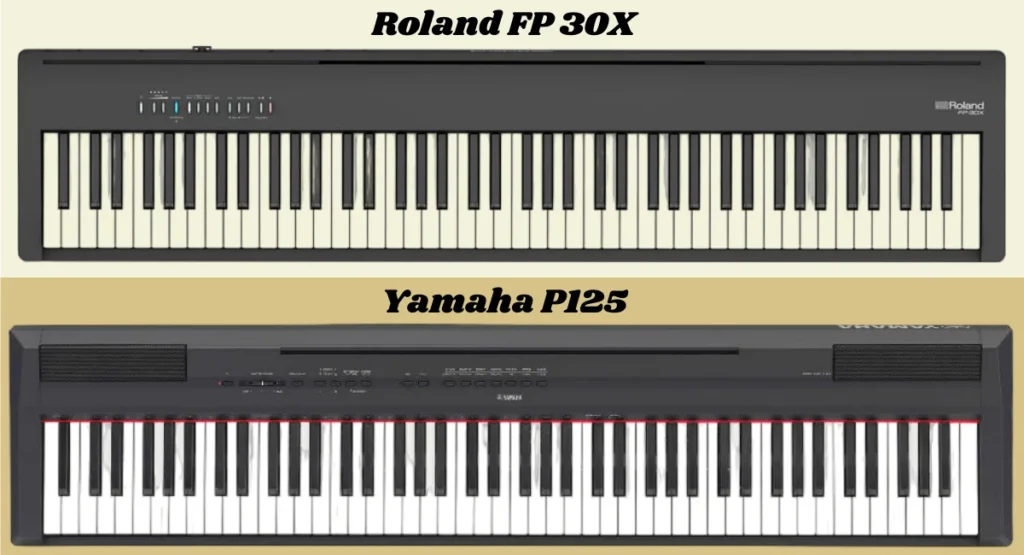Roland FP 10 vs Yamaha P45 are entry-level digital pianos from world-renowned brands, and they’re designed with beginners in mind. But the big question is: which one is the better choice for you as a beginner?
At first glance, the Roland FP 10 and Yamaha P45 might seem very similar. They’re both compact, budget-friendly, and offer 88 fully weighted keys that mimic the feel of an acoustic piano.
However, once you look a little deeper, you’ll notice differences in sound quality, key action, features, and connectivity that can really shape your playing experience.
The Roland FP 10 is praised for its superior key feel with Roland’s PHA-4 Standard action, which is often said to feel closer to a real acoustic piano. It also has a richer sound engine and Bluetooth connectivity, making it a great choice if you plan to use learning apps or play along with music.
On the other hand, the Yamaha P45 stands out for its simplicity and ease of use. It’s straightforward, lightweight, and trusted by many beginners who want an instrument that’s easy to set up and start playing right away.
When people ask me about the best digital piano for beginners, the Roland FP 10 and Yamaha P45 always come up. They’re affordable, simple, and trusted by two of the biggest names in the piano world. Since I’ve spent plenty of time playing both models, I thought it would be helpful to share what I’ve noticed, the good, the not-so-good, and which one might fit you better.
Table of Contents
Roland FP 10 vs Yamaha P45 Comparison Table
| Feature | Roland FP 10 | Yamaha P45 |
|---|---|---|
| Key Action | PHA-4 Standard (Progressive Hammer Action, Ivory Feel) | GHS (Graded Hammer Standard) |
| Polyphony | 96 notes | 64 notes |
| Voices/Tones | 15 | 10 |
| Sound Engine | SuperNATURAL Piano Modeling + Sampling | AWM Stereo Sampling |
| Speakers | 2 x 6W (downward-facing) | 2 x 6W (forward-facing) |
| Headphone Experience | Very immersive, natural resonance | Clear but less detailed |
| Connectivity | Bluetooth MIDI, USB-MIDI, Headphones | USB-MIDI, Headphones |
| Pedal Support | Supports half-pedaling (with upgrade) | No half-pedal support |
| App Support | Roland Piano Partner 2 (iOS/Android) | None |
| Modes | Dual Mode, Duet (Twin Piano) | Dual Mode only |
| Dimensions | 1,284 × 258 × 140 mm (50.5” × 10.2” × 5.5”) | 1,326 × 295 × 154 mm (52.2” × 11.6” × 6.1”) |
| Weight | 12.3 kg / 27.1 lbs | 11.5 kg / 25.4 lbs |
| Included Pedal | Basic footswitch (upgrade recommended) | Basic footswitch (no upgrade options for half-pedal) |
| Best For | Beginners + Intermediate players, long-term learning | Beginners who want simplicity + affordability |
My Experience Playing Both Digital Piano’s
I’ve been playing piano for years, from acoustic uprights to high-end digital models, but entry-level instruments always have a special place in my heart. Because they’re often someone’s very first step into the world of piano.
Both the roland FP 10 vs yamaha P45 are designed with beginners in mind, but they suit slightly different players:
- Roland FP 10: Best if you want a realistic piano feel right from the start, and you’re the type who cares about touch and tone. Great for students who eventually move to an acoustic piano.
- Yamaha P45: Best if you want simplicity, reliability, and ease of use without too many extra features. It’s perfect if you’re just beginning lessons or don’t want to fuss with apps and connectivity.
Keyboard & Key Action Of Roland FP 10 vs Yamaha P45

If your main goal is to develop proper piano technique and get a realistic playing feel, the Roland FP 10 clearly comes out on top. The Yamaha P45 is still perfectly fine for beginners, but it feels more like a “starter keyboard,” while the FP 10 feels closer to a “real piano”.
88 Weighted Keys: Roland’s PHA-4 vs Yamaha’s GHS
Both the Roland FP 10 and Yamaha P45 come with 88 fully weighted keys, which is essential for beginners who want to build proper finger strength and technique. But the feel of the keys is where these two start to differ.
Roland uses its PHA-4 Standard action, which is noticeably closer to an acoustic piano. The keys feel a bit heavier, and the mechanism gives you a more controlled response, especially when playing dynamics from soft to loud.
Yamaha, uses its GHS (Graded Hammer Standard) action, which is lighter and easier to press down. While this can make practicing less tiring for beginners, it doesn’t feel quite as realistic.
Triple Sensor vs Dual Sensor
The Roland FP 10’s triple sensor system makes a huge difference. It allows the keys to register repeated notes more accurately, even if you don’t fully release the key between presses. This is something you notice when playing fast passages or trills. The Yamaha P45 uses a dual sensor, which works fine for slow to medium-paced pieces but can feel a bit limiting if you try to play something more advanced.
Key Surface: Ivory Feel vs Smooth Plastic
This might sound like a small detail, but it really matters. The FP 10’s keys have a textured ivory feel, which gives your fingers better grip, especially during longer practice sessions. The P45’s keys are smooth plastic, which can feel slippery when your hands get a little sweaty.
Personally, I find Roland’s texture makes it easier to stay confident when playing fast or energetic pieces.
Escapement Mechanism: Why It Matters for Realism
Roland includes an escapement mechanism in the FP 10, which replicates the slight “notch” feeling you get when pressing a real grand piano key halfway down. It’s a subtle detail, but it adds realism for anyone who wants the experience of moving toward an acoustic piano.
Yamaha skips this feature in the P45, which makes it feel a little less authentic under the fingers.
Touch Sensitivity: 5 Levels vs 4 Levels
Finally, touch sensitivity. Both models let you adjust how the keys respond to your playing force, but Roland gives you 5 levels of adjustment, while Yamaha offers 4 levels. In practice, this means Roland has a bit more flexibility, you can make it more responsive for expressive pieces or lighter for casual practice.
Sound Engine & Tone Quality
If sound is your main priority, I’d say the Roland FP 10 is more inspiring to play. The Yamaha P45 is still a great beginner piano with a warm, straightforward tone, but it doesn’t give me the same expressive freedom.
Roland’s SuperNATURAL Piano Sound
The Roland FP 10 uses Roland’s SuperNATURAL piano engine, which is a mix of sampling and modeling. In simple terms, it doesn’t just play back a recording of a piano note, it also recreates the little details of how a real piano behaves.
When you play it, you can feel that extra “life” in the tone. Chords sound rounder, bass notes have a certain depth, and the transitions between soft and strong playing feel smooth.
Yamaha’s AWM Stereo Sampling
The Yamaha P45, uses AWM Stereo Sampling. Yamaha basically records a real acoustic piano and maps those recordings to the keys. The result is a clean and warm sound, especially in the upper register, which has that signature Yamaha brightness I’ve always loved.
When I switch back and forth between the two, the Yamaha feels a bit more “static.” It sounds beautiful for scales, exercises, and simpler pieces, but it doesn’t react to subtle changes in touch the way the Roland does.
Playing Both Side by Side
Here’s how I would sum up my experience when playing both:
- Tonal depth: The FP 10 feels fuller, especially in the lower range. The P45 sounds nice but flatter in comparison.
- Resonance: Roland includes string resonance (where other strings vibrate when you play a note). Yamaha leaves this out, so its notes sound cleaner but less realistic.
- Dynamic range: The FP 10 transitions more naturally from very soft to very loud. On the P45, the dynamics are there, but they feel less smooth.
Polyphony & Voices Comparison Of Roland FP 10 vs Yamaha P45
Polyphony might sound like a technical word, but it’s just about how many notes your piano can handle at once.
On the Roland FP 10, you get 96-note polyphony, while the Yamaha P45 gives you 64.
In real playing, here’s what that feels like: on the Roland, I never had to worry about notes dropping out, even when I am holding the sustain pedal and playing big chords. On the Yamaha, it’s fine for simple songs, but if you start layering sounds or playing more complex pieces, you might notice it cutting off a bit earlier.
As for voices, Roland has 15 tones and Yamaha has 10. To be honest, most of the time I stick with the main piano sound anyway. But when I want to mix things up, say practicing with an electric piano or adding some strings for fun, the extra options on the Roland do make practice feel a little less repetitive.
So, if you like variety and plan to explore beyond just the basic piano sound, the FP 10 gives you more room to play around. If you just want a straightforward piano without distractions, the P45 keeps it simple.
Built-in Speakers & Headphone Experience
Both the Roland FP 10 vs Yamaha P45 come with 2 x 6W speakers, so on paper they look pretty similar. But the way the sound projects is actually quite different.
Roland FP 10 Speaker
The Roland’s speakers face downward, which gives the sound a more diffused, room-filling effect. In my small practice room, it feels warm and balanced, almost like the notes are floating around me. The only downside is that if you’re sitting in a larger space, the sound can sometimes feel a little “softer” since it’s not directly projecting toward you.
Yamaha P45 Speaker
The Yamaha’s speakers, face forward, so the sound hits you directly. It feels a bit brighter and more focused, which I actually like when I’m sitting close and practicing. In a small room, though, it can feel slightly sharp compared to the Roland’s more natural spread.
Now, regarding headphones, I noticed a bigger difference. Roland’s SuperNATURAL engine really shines here, the tone feels rich and detailed, especially when you practice late at night. With the Yamaha, the headphone sound is clean, but it doesn’t have that same depth or “immersive” quality.
Connectivity & Extra Features

One of the biggest differences between these two pianos is in the connectivity. The Roland FP 10 has Bluetooth MIDI, and honestly, I use this all the time. I love connecting it wirelessly to practice apps, it makes things feel effortless. No cables, no clutter, just open an app on my iPad and the piano is ready to go. The Yamaha P45 doesn’t have Bluetooth, so if that’s something you’d find useful, the FP 10 definitely wins here.
Both pianos do have USB-MIDI, and I’ve tried them with my laptop for recording and practicing with virtual instruments. They both work great for that. I use GarageBand, and it’s nice being able to plug in the piano and immediately start layering sounds. If you’ve never tried this, it’s worth it, it really expands what these “beginner” pianos can do.
Now, here’s something that might matter depending on how you plan to use the piano: neither of them has a dedicated line-out. That means if you want to hook them up to external speakers, you have to use the headphone jack instead. I’ve done this with both pianos, and it works fine, but you do have to adjust the volume carefully to avoid distortion.
So for me, the Roland offers more here, it feels more flexible and modern. But if you don’t care about Bluetooth and just want something simple that works, the Yamaha still does the job.
App Support & Learning Tools For Beginners
If you value interactive tools, modern connectivity, and a little extra help in your learning journey, the Roland FP 10 has the edge. But if you prefer a no-fuss, traditional practice experience, the Yamaha P45 keeps things refreshingly simple.
Roland FP 10 works well with Roland’s Piano Partner 2 app (available for iOS and Android). Instead of memorizing button shortcuts on the piano itself, you can control sounds, rhythms, and settings directly from your phone.
For a beginner, this convenience can take away a lot of frustration. The app also adds interactive learning tools, like built-in rhythms and exercises, which helps in improving timing when practicing at home.
The Yamaha P45 doesn’t offer app support, and while that may sound like a limitation. The P45 is built to be as straightforward as possible, switch it on, select your voice, and start playing. If you don’t care about extra tech or want to avoid distractions, this simplicity can actually be a strength.
Both keyboards cover the essentials: they have a metronome and transpose function. The Roland’s controls are slightly more flexible, especially when experimenting with different practice pieces, while Yamaha keeps things basic but effective.
When it comes to modes, both allow Dual Mode (layering sounds), but in my playing, I preferred Yamaha’s blending of layered tones, it sounded smoother to my ears. The Roland, however, includes Duet Mode (Twin Piano), which splits the keyboard into two identical pitch ranges.
Pedals & Playing Feel
Both the Roland FP 10 vs Yamaha P45 come with a basic sustain footswitch in the box. Honestly, it feels more like a computer game pedal than something built for serious piano practice. It works, but it’s very “on or off”, you press it, and the sound sustains; you release it, and it cuts off immediately.
For absolute beginners, this might be fine for a while, but as soon as you start playing pieces that rely on subtle pedal work, you’ll notice the limitation.
Roland FP 10 has a clear edge: it supports half-pedaling when paired with a proper damper pedal like the Roland DP-10 or DP-2. I tested this, and the difference is huge. With half-pedaling, you can control how much sustain you add, just like on an acoustic piano. This makes your playing feel more expressive and natural, especially for classical or lyrical pieces.
The Yamaha P45 doesn’t support half-pedaling. Even if you plug in a nicer pedal, it still only works as a simple on/off switch. That means you don’t get the same nuanced control over resonance. For beginners focusing on basics, it’s not a dealbreaker, but if you plan to grow with your piano skills, it’s a limitation worth keeping in mind.
Dimensions & Portability
Both are “grab-and-go” digital pianos and great for small apartments or dorm rooms. If you care about a sleeker, more compact footprint, the FP 10 has the edge. If you prefer something just a touch lighter to carry, the P45 wins (though the difference is minimal).
Roland FP 10 vs Yamaha P45 are both compact 88-key pianos, but there are some small differences that might matter depending on your space and setup.
The Roland FP 10 measures about 50.5” wide and 10.2” deep, and it weighs 12.3 kg (27.1 lbs). The Yamaha P45 is a little wider and deeper at 52.2” x 11.6”, but it’s slightly lighter at 11.5 kg (25.4 lbs).
Now, what does that mean in real life? Honestly, the weight difference is so small that you won’t really notice it when lifting them, both are light enough for one person to carry without struggling. I’ve moved them around my practice room and even taken them in the car, and neither gave me trouble.
Where I did notice a difference was in depth (front to back). The Yamaha P45 is a bit bulkier, so if you’re setting up in a very tight space, like a small desk or a narrow stand, the Roland FP 10 feels slightly more streamlined. On the other hand, Yamaha’s wider design doesn’t really affect portability, but it does take up a little more room visually.
Bottom line: You can’t go wrong with either for portability, but the FP 10 looks and feels a bit more space-friendly, while the P45 is technically the lighter one to move.
Pros And Cons
Roland FP 10
Pros
Realistic key feel
Triple sensor action
Escapement mechanism
Ivory key texture
Bluetooth MIDI support
SuperNATURAL sound engineCompact design
Cons
Limited voices
No line out
Small speakers
Yamaha P45
Pros
Lightweight build
Simple interface
Trusted Yamaha tone
Dual mode layering
Affordable price
Decent key feel
Beginner friendly
Cons
Dual sensor only
No app support
Fewer features
Who Should Buy Which?
Best Choice for Absolute Beginners
If you’re just starting piano and want something that “just works” without complication, the Yamaha P45 is a solid pick. Its straightforward design, user-friendly interface, and reliable sound make it ideal for learners who want to dive right in. There’s no Bluetooth, no apps to navigate, just power on and play.
In short: Perfect for anyone who values simplicity, affordability, and ease of use.
Best Choice for Growing or Intermediate Players
When you’re ready to take your skills further, or you already have some experience. The Roland FP 10 stands out. It offers more advanced features like triple-sensor keys, escapement, richer sound through the SuperNATURAL engine, Bluetooth MIDI, and app support. These add layers of realism and flexibility to your practice, letting you grow into a more expressive player.
In short: Great for players who want to elevate their technique and experience.
My Advice for Students & Hobbyists
- If you’re a student working with a teacher, the Roland FP 10 can better support your progression. The realistic touch and ability to fine-tune techniques like half-pedaling or dynamic expression will better reflect what instructors teach on acoustic pianos. Plus, Duet Mode is a big bonus during lessons.
- For casual players or hobbyists, it depends how deep you want to go. If you’re playing for fun and don’t mind a simpler hands-on experience, the Yamaha P45 delivers. But if you love tinkering with apps, learning tools, or want future flexibility, the FP 10 gives you more options, without feeling over-complicated.
Final Thoughts
After spending real practice hours with both the Roland FP 10 vs Yamaha P45, I can say each piano has its own strengths and the right choice really depends on where you are in your piano journey.
The Yamaha P45 wins for its simplicity, affordability, and reliability. It’s the kind of piano you can unbox, plug in, and immediately start playing without distraction. For absolute beginners or hobbyists who just want a no-fuss practice piano, it’s a safe and satisfying pick.
The Roland FP 10, on the other hand, feels like a step closer to an acoustic experience. Its triple-sensor action, textured keys, escapement, and richer tone engine give you more realism and room to grow. Add in Bluetooth connectivity, app support, and Duet Mode, and it clearly edges out the Yamaha when it comes to features for learning and progression.
My Recommendation:
- If you’re brand new and just want something simple and budget-friendly, go with the Yamaha P45.
- If you’re a serious beginner, student, or intermediate player who wants to invest in long-term growth, the Roland FP 10 is the smarter choice.
Either way, both pianos deliver solid value, and you can’t really go wrong. It just comes down to whether you want a basic practice companion or a more advanced digital piano that grows with you.
Frequently Asked Questions
Is the Roland FP 10 better than the Yamaha P45 for beginners?
Both are beginner-friendly, but the Roland FP 10 feels closer to a real piano because of its PHA-4 Standard action and more expressive sound engine.
Which digital piano has better key action: Roland FP 10 vs Yamaha P45?
The Roland FP 10’s PHA-4 Progressive Hammer Action feels more natural and realistic compared to Yamaha’s GHS action, especially for players used to acoustic pianos.
Does polyphony really matter between Roland FP 10 (96 notes) and Yamaha P45 (64 notes)?
Yes. While 64-note polyphony is fine for simple pieces, the FP 10’s 96 notes handle complex passages and sustain pedal use more smoothly.
Which one is lighter and more portable?
The Yamaha P45 is slightly lighter (25.4 lbs) compared to the FP 10 (27.1 lbs), making it a bit easier to move, though both are manageable.
Which one should I buy if I plan to stick with piano long-term?
If you want a digital piano that grows with you, the Roland FP 10 is the better investment thanks to its advanced key action, tone modeling, and app support.



